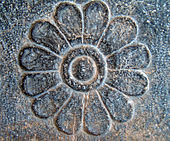

TYPE: Fertility Goddess
ORIGIN: Persian [Iran]
INFORMATION: Her influence extended through eastern Europe. In pre-Christian Armenia, the center of her cult was at Acilisena, where noble families regularly surrendered their daughters to serve as cultic prostitutes.
Anahita is the Old Persian form of the name of an Iranian goddess and appears in complete and earlier form as Aredvi Sura Anahita (Aredvi Sura Anahita), the Avestan name of an Indo-Iranian cosmological figure venerated as the divinity of "the Waters" (Aban) and hence associated with fertility, healing and wisdom. There is also a temple named Anahita in Iran. Aredvi Sura Anahita is Ardwisur Anahid or Nahid in Middle and Modern Persian, and Anahit in Armenian. An iconic shrine cult of Aredvi Sura Anahita was – together with other shrine cults – "introduced apparently in the 4th century BCE and lasted until it was suppressed in the wake of an iconoclastic movement under the Sassanids." The symbol of goddess Anahita is the Lotus flower. Lotus Festival (Persian: Jashn-e Nilupar) is an Iranian festival that is held on the sixth day of July. Holding this festival at this time was probably based on the blooming of lotus flowers at the beginning of summer.
The Greek and Roman historians of classical antiquity refer to her either as Anaïtis or identified her with one of the divinities from their own pantheons. 270 Anahita, a silicaceous S-type asteroid, is named after her. Based on the development of her cult, she was described as a syncretistic goddess, who was composed of two independent elements. The first is a manifestation of the Indo-Iranian idea of the Heavenly River who provides the waters to the rivers and streams flowing in the earth while the second is that of a goddess of uncertain origin, though maintaining her own unique characteristics, who became associated with the cult of the ancient Mesopotamian goddess Inanna-Ishtar. According to one theory, this arose partly from a desire to make Anahita part of Zoroastrianism following the diffusion of her cult from the extreme northwest into the rest of Persia.
According to H. Lommel, the proper name of the divinity in Indo-Iranian times was Sarasvati, which also means "she who possesses waters". In Sanskrit, the name (Ardravi Sura Anahita) means "of the waters, mighty, and immaculate". Like the Indian Sarasvati, Anahita nurtures crops and herds; and she is hailed both as a divinity and as the mythical river which she personifies, "as great in bigness as all these waters which flow forth upon the earth" (Yasht 5.3).